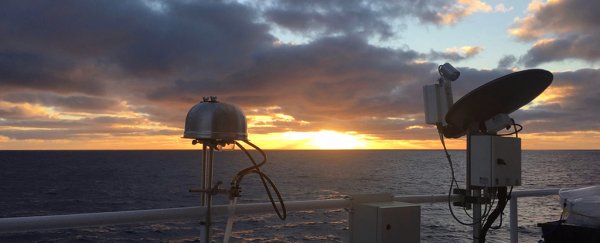We've seen plenty of scientific reports on poor air quality, but a new study takes the opposite approach: using samples collected out on the ocean and some modelling, it identifies what may well be the cleanest pocket of air in Earth's atmosphere.
That pocket is in the Southern Ocean between Tasmania and Antarctica, between 54 and 62 degrees latitude. Researchers say its boundary layer, which sits on top of the ocean surface and feeds low-level clouds, seems to be free of aerosols blown in from other parts of the world. This would imply it's also free of the bulk of pollutants produced by human activity.
The conclusions are based on airborne bacteria measurements, which become much less diverse further south towards Antarctica. In this part of the ocean, the bacterial make-up is dominated by marine spray microorganisms and very little else.
"We were able to use the bacteria in the air over the Southern Ocean [SO] as a diagnostic tool to infer key properties of the lower atmosphere," says microbial ecologist Thomas Hill, from Colorado State University.
"For example, that the aerosols controlling the properties of SO clouds are strongly linked to ocean biological processes, and that Antarctica appears to be isolated from southward dispersal of microorganisms and nutrient deposition from southern continents."
This is the first time that a bioaerosol sampling of the Southern Ocean this close to Antarctica has been carried out, and the cleanliness of the air came as a surprise to researchers, considering how interconnected the world's weather systems are.
Microorganisms can travel huge distances on the wind, but very few have travelled this far, it seems. The scientists used a combination of DNA sequencing, source tracking and wind trajectory models to figure out where the particles in their sample area were from.
The samples were also split into latitudinal zones so the team could see the changes as they moved further south. The findings counter similar studies carried out elsewhere, in the subtropics and northern hemisphere, which show microbes travelling and mixing.
Besides giving this part of the Southern Ocean the top prize for purity, the research is also important for climate and weather modelling. The aerosol make-up of the boundary layer affects cloud composition and precipitation, which then affects the amount of sunlight reaching Earth's surface.
In fact, the concentration of ice-nucleating particles – which freeze cloud droplets and are often from plants or soil – is lower over the Southern Ocean than anywhere else on the planet, previous research has shown.
"Overall, it suggests that the SO is one of very few places on Earth that has been minimally affected by anthropogenic activities," says Hill.
The research has been published in PNAS.
